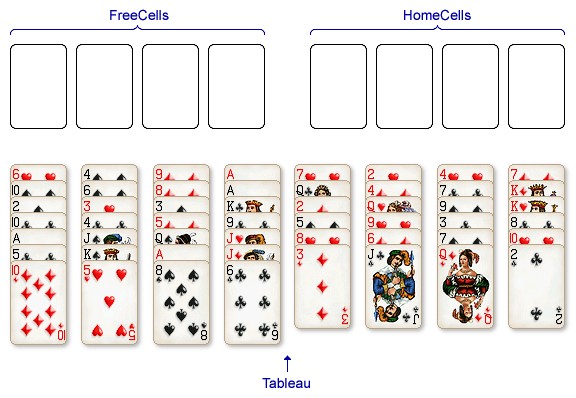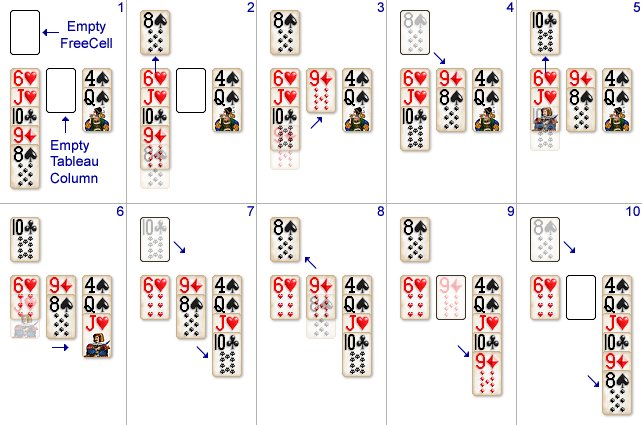Game Won!
If you enjoy using this App,
Thanks for your support!
No more moves
Congratulations!
How to Play Klondike Solitaire!
Card Layout
The game is played with a single pack of 52 playing cards. After thoroughly shuffling the deck, a row of eight cards is dealt face up to start the tableau. A further five rows of eight cards are dealt face up on top of the first to form eight columns of six cards each. The final four cards are dealt to the first four columns so that the first four columns in the tableau each contain seven cards and the last four columns on the right each contain six cards.

FreeCell Rules
The exposed card at the end of each tableau column is available for play. You may move it to an empty FreeCell at any time to release the card beneath, but it's a good idea to keep the FreeCells empty for as long as possible. As each Ace becomes available it may be transferred to one of the HomeCells. The HomeCells are built up in ascending suit sequence to the King. You may move an exposed card from end of a tableau column or from a FreeCell to another tableau column if it will form a descending sequence of alternating colours, e.g. Empty spaces in the Tableau can be filled by any card you like, but don't waste them as empty tableau spaces are very powerful as we will see later. You keep moving single cards, one at a time, until the game either blocks or comes out.
Moving a Sequence of Cards
Although the rules of FreeCell permit you to move just one card at a time, the empty FreeCells allow you to move an entire sequence of packed cards:
Now imagine if one of the above FreeCells were already occupied by a card leaving only three empty. It wouldn't be possible to transfer a five card sequence with single card movements; you could only move four. As a rule of thumb, the size of the packed column that you can transfer is equal to the number of empty FreeCells plus one (this increases if you have empty tableau columns as we will see later). It would be rather tedious if you had to juggle all these cards around manually in order to move a packed sequence and you'll be pleased to hear that just like any decent computer version of FreeCell worth its salt, Solitaire City automates this process for you. You may move an entire packed sequence of cards to another column by clicking on the card that heads the sequence and dragging the entire sequence over, just like you do in Klondike and other games. You'll then see the cards make their correct single card moves, but it will all happen quickly and automatically saving you much time and effort. Solitaire City will also calculate the maximum sequence size that you can move based on the number of empty FreeCells and tableau columns and will only let you drag the permitted number of cards.
Supermoves
Usually, the maximum number of cards you can move at once is equal to the number of empty FreeCells plus one. However, this number doubles for every empty tableau column (unless you're moving the sequence to an empty tableau column, then that column doesn't count). This is because an empty tableau column acts like an extra FreeCell, only it's more powerful because you can pack extra cards onto it. If you had four empty FreeCells and an empty tableau column then you would be able to move a sequence of ten cards rather than five, by moving the first five packed cards to the empty tableau column using the four FreeCells as temporary storage space as in the above example. You then move the remaining five cards to their destination column by using the four FreeCells and finally you move the five cards you packed into the empty tableau column over to the destination column, again using the four FreeCells as temporary storage space. It sounds complicated, but Solitaire City does the move automatically for you. Just drag the entire packed column over and watch the magic happen. Whenever you move a sequence of cards using an empty tableau column, it's called a "Supermove".

Once again, you don't need to concern yourself with this complicated move while playing Solitaire City. Just drag the entire packed sequence of cards over to the second tableau column and then watch the computer go to work. It's good to know what's going on though so you understand why the computer will allow you to drag say four cards one time and only two at another.
Special Controls
Press the right mouse button over a covered tableau card to reveal more of the card.